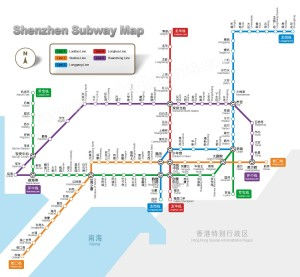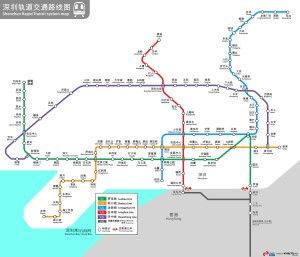Shenzhen subway (深圳地铁) It is the mass transportation system that operates in the city of Shenzhen, China.
Inaugurated on 28 December 2004, This system has grown rapidly to become one of the most extensive in the world. At the moment, has 11 lines covering a total length of 555,4 kilometres (345.1 miles), and has 373 stations.
subway map
Below we show you the Shenzhen metro map in various versions. Click on the image to see it larger and in high quality:
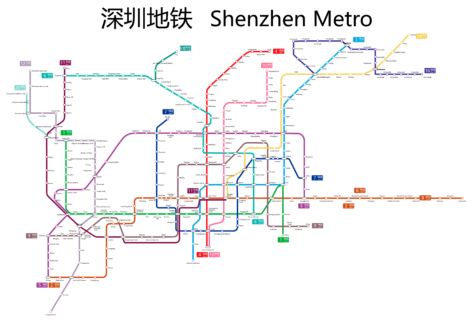
Version of the Shenzhen metro map in PDF format.
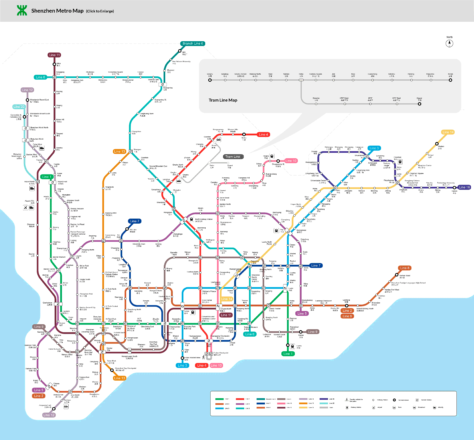
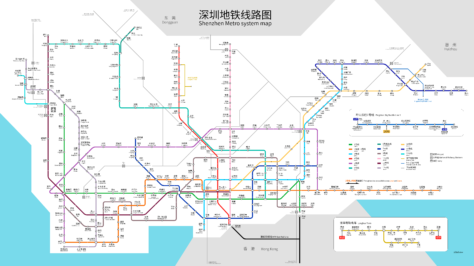
Schedules
- Working days and holidays: 6:30h a 23:00h.
Shenzhen subway fares
Shenzhen subway uses fare system based on distance traveled, with prices that vary depending on the length of the trip. Here is a table with the main prices in yuan (CNY) and its equivalent in US dollars (USD) so that tourists get a better idea of the price:
| Distance (km) | Precio (CNY) | Precio (USD) |
|---|---|---|
| 0 – 4 | 2 | 0.29 |
| 4 – 12 | 3 | 0.43 |
| 12 – 24 | 4 | 0.57 |
| 24 – 36 | 5 | 0.72 |
| 36 – 52 | 6 | 0.86 |
| 52 – 72 | 7 | 1.00 |
| 72 – 100 | 8 | 1.14 |
| 100+ | 9 | 1.29 |
The metro also offers several cards and special discounts:
- Shenzhen Tong Card: Rechargeable card used for frequent trips, that offers discounts and makes payment easy.
- Student card: Provides reduced rates for students.
- concession card: Allows free rides for children under 6 years, people older than 60 years and people with disabilities.
- Tourist Card: Offers unlimited rides for a set period, ideal for visitors.
Official Web site
- This is the official website: metro de Shenzhen
History of Shenzhen Subway
The Shenzhen metro begins its history in the years 80. In 1983, The Shenzhen government decided to reserve space for a mass transportation system in the city center. This first step laid the foundation for the metro we know today..
In 1992, The State Planning Commission approved the proposal for an urban rail transportation system. In 1998, construction of the first phase began, which included the lines 1 y 4.
2004, inauguration of the first lines
The 28 December 2004, the metro began its operations with the lines 1 (Luobao) y 4 (Longhua). The line 1 connects central Shenzhen with Bao'an district, while the line 4 goes from the center to Longhua.
Rapid expansion: 2010-2020
In between 2010 y 2020, Shenzhen metro underwent significant expansion. New lines and extensions to existing ones were added:
- Line 2 (Shekou): Inaugurated in December 2010, connects Shekou port with the center.
- Line 3 (Longgang): Open in December 2010, This line runs from Longgang district to central Shenzhen.
- Line 5 (Huanzhong): It began operating in June 2011, covering key areas of western and central Shenzhen.
- Line 7 (Xili): Inaugurated in October 2016, crosses the city from east to west.
Recent projects and future expansions
In 2020, several new lines were opened, including the line 6 and the line 10. The most recent expansion in 2023 added new stations and improved connectivity between districts.
The last Shenzhen subway station to open is the 松岗公园站 (Songgang Park Station). This station opened on 27 December 2023, as part of the expansion of line 6. The development of the Shenzhen metro has been possible thanks to the collaboration of several companies, including the Shenzhen Metro Group y MTR Corporation de Hong Kong.
Looking to the future, further expansions are planned until 2025, with the aim of overcoming the 650 kilometers of total network.
History of Shenzhen subway map
The first Shenzhen subway map was designed in parallel with the construction of the first lines in the late 1920s. 90 and principles of 2000. This initial design was the work of local urban planning teams and the Shenzhen Metro Group.
With the opening of new lines, especially between 2010 y 2020, the map required continuous updates. Companies like MTR Corporation, responsible for the operation of several lines, They also contributed to the design of the map. In this stage, Distinctive colors were integrated for each line, improving visual differentiation and facilitating navigation for passengers.
The French company Alstom and the Japanese Hitachi have collaborated on several Shenzhen metro expansion projects, bringing advanced technology and experiences from other global metro systems. His contributions were not limited only to train and station engineering., but also to the design of the signaling system and interactive maps in the stations.
Digital Maps and Modernization: With technological growth, Shenzhen subway map was digitized and modernized. Mobile applications and interactive screens appeared at stations, where dynamic and real-time maps are provided, developed in collaboration with local technology companies such as Huawei. These maps offer instant updates, information on waiting times and route alternatives, adapting to the fast-paced life of Shenzhen.
Additional data
Shenzhen is a city known for its technological innovation and economic growth, being an important hub for technology companies. The metro connects residential areas with business centers, and at the same time also facilitates access to key tourist sites such as the theme park Window of the World and the Splendid China Folk Village.
Besides, Shenzhen metro stands out for its modern infrastructure and advanced technologies, including driverless trains on some lines.
These are the most important tourist sites in Shenzhen, with the nearest line and station:
- 深圳湾公园 (Shenzhen Bay Park) (line 2, season 滨海公园): Extensive coastal park ideal for walks and bike rides.
- 东门老街 (Dongmen Pedestrian Street) (line 1, season 老街): Historic shopping street with numerous shops and food outlets.
- 海上世界 (Sea World) (line 2, season 海上世界): Tourist complex built on an old cruise ship, with night shows.
- 仙湖植物园 (Xianhu Botanical Garden) (line 5, season 仙湖路): Botanical garden with a diversity of plants and the famous temple 弘法寺.
- 关山月美术馆 (Guanshanyue Art Museum) (line 3, season 华强北): Art museum exhibiting works by local and national artists.
- 中英街 (Chung Ying Street) (line 2, season 沙头角): Historic street known for its cheap shops and historical value.
- 莲花山公园 (Lianhuashan Park) (line 3, season 莲花北): Central park with panoramic views and the statue of Deng Xiaoping.
- 欢乐谷 (Happy Valley) (line 1, season 华侨城): Theme park with various attractions and live shows.
Old Shenzhen subway maps
In historical mode, We are posting old subway maps in this section, at the moment they are all years 2014:

